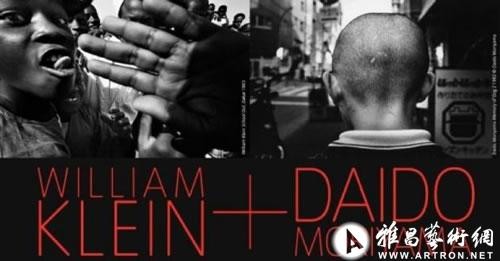
Daido Moriyama And William Klein Two Monochrome Image Junkies
2012-10-24 12:02:42 未知

Review - So it's another belter from Simon Baker whose appointment as Head of Photography for the Tate has proven to be a good choice. After the excellent 'Another London' at the Tate Britain, he brings us this initially unlikely pairing of two monochrome image junkies, Working with a co-curator, as he did with the Tate Britain show, he has produced the most photographic of recent Tate photography shows,. No concepts here, unless obsessive addiction to image-making could be called conceptual, but rather 'series', the word most photographers would use to describe a body of work but wouldn't usually utter in the hallowed Turbine halls. Not since 'Robert Frank: Storylines' has the Tate been so prepared to see Photography as a medium apart, in its own right and still welcome it into the fold.
The show is split into two retrospectives. Using innovative presentation and sophisticated curation, it creates links between the two artists lightly, without the minor condescension one might expect from a Tate show. What Moriyama and Klein have in common is an avant-garde, confrontational style that defied the conventions of common practice, a desire to penetrate the urban city-space to its core and, perhaps most importantly, making some of the most influential photo-books of the 20th century. The camera is as weapon here; aggressive, unremitting, violent even. Both artists hunt images that distil a quintessential human vitality, be it conflict or desire, without losing sight of their own vulnerabilities; no cool detachment, no topographic mastery of the world, but immersion in and amongst those people and places Daido Moriyama and William Klein presume to photograph.
Wiliam Klein's section is divided into 7 rooms. Starting with one his early films, then charting his entree into Art Photography via editorial work for Vogue in New York, documenting the city like 'Crazed Paparazzo' (Klein's words). This approach proved to be foundational in his fine art practice, particularly in his New York work, and as one wonders through the rooms it becomes clear that this early juxtaposition of commercialism with personal response was key in developing his point of view. Klein turns the residents of a city into exhibitionists, provoking them into, if not posing, engaging with his lens in such a way as to stake their claim in this cityscape, assert their presence in Klein's testimony to a crazy space in time. Other rooms show his work in other cities as well as some more film work and ventures into graphics. A room featuring his painted over contact sheets is especially powerful. Klein's is a brutal compassion for his fellow man, a stark and unflinching honesty that is, ultimately, driven by love. The high-contrast, black and white, wide angle style for which he has garnered renown is merely the surface of an ocean. For Moriyama, however, the surface is the ocean.
Moriyama inhabits the grain. His work, though broken up into series with some demarcation, is essentially a life-long exploration of what lies within the the texture of his environment. This isn't strict documentation per se, although arguably no one, even his former mentor Shomei Tomatsu, has done more to capture Tokyo, but an experimental examination of the spaces between fact and fiction. His subjective, diaristic work, feeds into the myth he seeks to inhabit as perpetual chronicler. Sexual, obsessive, sinister and often funny, his images, consistent in their aesthetic, engage with an existentialist dilemma common to most of the best modernist photography: how to capture the void? Moriyama both fights and acquiesces to the ennui, yet does so with such invention that it does give one hope. Energy is all one needs; the camera as organ, as liberator.
Moriyama's strongest work comes in Room 3, in which various prints from three of his seminal books are presented alongside said publications in cabinets. In 'Hunter', inspired by Kerouac's 'On the Road', Moriyama takes to the road, capturing the essence of vehicular transience, and the road, its markings as it recedes into the horizon. In 'Another Country In New York', the artist presents vertically stacked diptychs of the City as alienator, estranger, dominated by neon signage and lonely streets. Arguably his most famous work is 'Farewell Photography', his modernist tour de force in which he sought to push at the boundaries of analogue photography. Scratches, blurs, flashes and grain, so much grain, are the subject of these images. The photographic equivalent of of tv noise fused with a distant, urban ambience. Also excellent is the slideshow in room 5, showing images taken on Hokkaido island in the late 70's. This is the most personal work on display, in which one does get a glimpse of the beating heart at the source of Moriyama's magnificent obsession.
This is a great show by the Tate, and one that, hopefully, will usher in even more developed commitment to Photography by major art institutions. Don't miss it!
(责任编辑:刘正花)
注:本站上发表的所有内容,均为原作者的观点,不代表雅昌艺术网的立场,也不代表雅昌艺术网的价值判断。
 阿拉里奥画廊上海转型:为何要成为策展式艺术商业综合体?
阿拉里奥画廊上海转型:为何要成为策展式艺术商业综合体? 李铁夫冯钢百领衔 作为群体的早期粤籍留美艺术家
李铁夫冯钢百领衔 作为群体的早期粤籍留美艺术家 OCAT上海馆:参与构建上海艺术生态的十年
OCAT上海馆:参与构建上海艺术生态的十年 “纤维”提问2022:存在何“缓”?
“纤维”提问2022:存在何“缓”?
全部评论 (0)